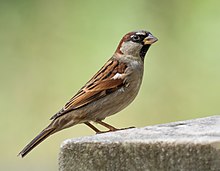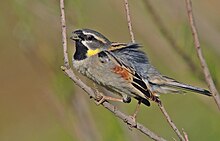Old World sparrow
| Old World sparrow | |
|---|---|

| |
| Male house sparrow (Passer domesticus) | |
| Scientific classification | |
| Domain: | Eukaryota |
| Kingdom: | Animalia |
| Phylum: | Chordata |
| Class: | Aves |
| Order: | Passeriformes |
| Suborder: | Passeri |
| Infraorder: | Passerida |
| Superfamily: | Passeroidea |
| Family: | Passeridae Rafinesque, 1815 |
| Type genus | |
| Passer Brisson, 1760
| |
| Genera | |
| |
Old World sparrows are a group of small
Description



Generally, Old World sparrows are small, plump, brown and grey birds with short tails and stubby, powerful
Taxonomy and systematics


The family Passeridae was introduced (as Passernia) by the French
Many early classifications of the Old World sparrows placed them as close relatives of the weavers among the various families of small seed-eating birds, based on the similarity of their breeding behaviour, bill structure, and moult, among other characters. Some, starting with P. P. Suskin in the 1920s, placed the sparrows in the weaver family as the subfamily Passerinae, and tied them to Plocepasser. Another family sparrows were classed with was the finches (Fringillidae).[4]
Some authorities previously classified the related
Despite some resemblance such as the seed-eater's bill and frequently well-marked heads,
| ||||||||||||||||||||||||||||||
| Phylogeny based on a study by Martin Päckert and colleagues published in 2021. The Hypocryptadius were not sampled.[13]
|
Species
The family contains 43 species divided into eight genera:[14]
| Image | Genus | Living species |
|---|---|---|

|
Hypocryptadius |
|

|
Carpospiza
|
|

|
Petronia
|
|

|
Onychostruthus
|
|

|
Montifringilla |
|

|
Pyrgilauda |
|

|
Gymnoris |
|
 |
Passer, the true sparrows |
|
Distribution and habitat

The Old World sparrows are indigenous to Europe, Africa and Asia. In the Americas, Australia, and other parts of the world, settlers imported some species which quickly naturalised, particularly in urban and degraded areas. House sparrows, for example, are now found throughout North America, Australia (every state except Western Australia), parts of southern and eastern Africa, and over much of the heavily populated parts of South America.[4]
The Old World sparrows are generally birds of open habitats, including
Behaviour and ecology
Old World sparrows are generally social birds, with many species breeding in loose colonies and most species occurring in flocks during the non-breeding season. The great sparrow is an exception, breeding in solitary pairs and remaining only in small family groups in the non-breeding season. They form large roosting aggregations in the non-breeding seasons that contain only a single species (in contrast to multi-species flocks that might gather for foraging). Sites are chosen for cover and include trees, thick bushes and reed beds. The assemblages can be quite large with up to 10,000 house sparrows counted in one roost in Egypt.[4]
The Old World sparrows are some of the few passerine birds that engage in
-
Sudan golden sparrows, seen here on the Red Sea coast of Sudan, are highly gregarious outside of the breeding season.
-
Eggs
The house sparrow typically lays 3-6 eggs, but has been known to lay as few as 1 and as many as 8 greenish-white eggs. The incubation period is typically 10–14 days.[15]
Relationships with humans
Old World sparrows may be the most familiar of all wild birds worldwide.[16] Many species commonly live in agricultural areas, and for several, human settlements are a primary habitat. The Eurasian tree and house sparrows are particularly specialised in living around humans and inhabit cities in large numbers. 17 of the 26 species recognised by the Handbook of the Birds of the World are known to nest on and feed around buildings.[4]
Grain-eating species, in particular the house and Sudan golden sparrows, can be significant agricultural
Because of their familiarity, the house sparrow and other species of the family are frequently used to represent the common and vulgar, or the lewd.
Jesus's use of "sparrows" as an example of divine providence in the Gospel of Matthew[19] also inspired later references, such as that in the final scene of Shakespeare's Hamlet[17] and the Gospel hymn "His Eye Is on the Sparrow".[20]
| |
Old World sparrows have been kept as pets at many times in history, even though most are not particularly colourful and their songs are unremarkable.[citation needed] They are also difficult to keep, as pet sparrows must be raised by hand and a considerable amount of insects are required to feed them. Nevertheless, many people succeed at hand-raising orphaned or abandoned baby sparrows.[22]
The earliest mentions of pet sparrows are from the Romans. Not all the passeri mentioned, often as pets, in Roman literature were necessarily sparrows, but some accounts of them clearly describe their appearance and habits.[23] The pet passer of Lesbia in Catullus's poems may not have been a sparrow, but a thrush or European goldfinch. John Skelton's The Boke of Phyllyp Sparowe is a lament for a pet house sparrow belonging to a Jane Scrope, narrated by Scrope.[4][17][23][24]
References
Citations
- ^ Summers-Smith 2005, p. 17
- ISBN 978-1-85391-186-6.
- ISBN 978-0-691-03424-9.
- ^ ISBN 978-84-96553-50-7.
- ^ Rafinesque, Constantine Samuel (1815). Analyse de la nature ou, Tableau de l'univers et des corps organisés (in French). Vol. 1815. Palermo: Self-published. p. 68.
- hdl:2246/830.
- ^ .
- ^ Christidis & Boles 2008, p. 177
- Rasmussen, Pamela, eds. (January 2021). "New World Sparrows, Bush Tanagers". IOC World Bird List Version 11.1. International Ornithologists' Union. Retrieved 2 June 2021.
- ^ American Ornithologists' Union. 1998. Check-list of North American Birds. 7th edition. American Ornithologists' Union, Washington, D.C.
- ]
- ^ Summers-Smith 1988, p. 13
- .
- ^ Gill, Frank; Donsker, David, eds. (2018). "Old World sparrows, snowfinches, weavers". World Bird List Version 8.1. International Ornithologists' Union. Retrieved 8 May 2018.
- ^ "Hoiuse Sparrow". Aububon.ordg. 13 November 2014.
- ISBN 978-1-55297-777-4.
- ^ a b c d Summers-Smith 1963, pp. 49, 215
- ^ Shipley, A. E. (1899). "Sparrow". In Cheyne, Thomas Kelley; Black, J. Sutherland (eds.). Encyclopaedia Biblica. Vol. 4. Toronto : Morang.
- ^ Matthew 10:29–31
- ^ Todd 2012, pp. 56–58
- ^ Houlihan & Goodman 1986, pp. 136–137
- ^ "Starling Talk: The Care and Feeding of Injured and Orphaned Starlings".
- ^ a b Summers-Smith 2005, pp. 29–35
- ^ Ferber, Michael (2007). "Sparrow". A Dictionary of Literary Symbols. Cambridge University Press. Archived from the original on 2013-07-24. Retrieved 2017-11-01.
Works cited
- Christidis, L.; Boles, W. E. (2008). Systematics and Taxonomy of Australian Birds. Canberra: CSIRO Publishing. ISBN 978-0-643-06511-6.
- Houlihan, Patrick E.; Goodman, Steven M. (1986). The Natural History of Egypt, Volume I: The Birds of Ancient Egypt. Warminster: Aris & Philips. ISBN 978-0-85668-283-4.
- Summers-Smith, J. Denis (1963). The House Sparrow. New Naturalist (1st. ed.). London: Collins.
- Summers-Smith, J. Denis (1988). The Sparrows. illustrated by Robert Gillmor. Calton, Staffs, England: T. & A. D. Poyser. ISBN 978-0-85661-048-6.
- Summers-Smith, J. Denis (2005). On Sparrows and Man: A Love-Hate Relationship. Guisborough (Cleveland). ISBN 978-0-9525383-2-5.)
{{cite book}}: CS1 maint: location missing publisher (link - Todd, Kim (2012). Sparrow. Animal. Reaktion Books. ISBN 978-1-86189-875-3.
External links
- Passeridae Archived 2016-03-14 at the Wayback Machine at the Internet Bird Collection


